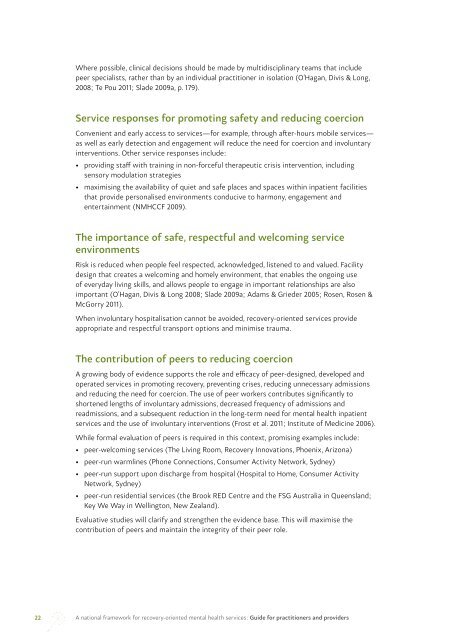6 Recovery, self-determination and safety
6 Recovery, self-determination and safety
6 Recovery, self-determination and safety
Create successful ePaper yourself
Turn your PDF publications into a flip-book with our unique Google optimized e-Paper software.
Where possible, clinical decisions should be made by multidisciplinary teams that include<br />
peer specialists, rather than by an individual practitioner in isolation (O’Hagan, Divis & Long,<br />
2008; Te Pou 2011; Slade 2009a, p. 179).<br />
Service responses for promoting <strong>safety</strong> <strong>and</strong> reducing coercion<br />
Convenient <strong>and</strong> early access to services—for example, through after-hours mobile services—<br />
as well as early detection <strong>and</strong> engagement will reduce the need for coercion <strong>and</strong> involuntary<br />
interventions. Other service responses include:<br />
• providing staff with training in non-forceful therapeutic crisis intervention, including<br />
sensory modulation strategies<br />
• maximising the availability of quiet <strong>and</strong> safe places <strong>and</strong> spaces within inpatient facilities<br />
that provide personalised environments conducive to harmony, engagement <strong>and</strong><br />
entertainment (NMHCCF 2009).<br />
The importance of safe, respectful <strong>and</strong> welcoming service<br />
environments<br />
Risk is reduced when people feel respected, acknowledged, listened to <strong>and</strong> valued. Facility<br />
design that creates a welcoming <strong>and</strong> homely environment, that enables the ongoing use<br />
of everyday living skills, <strong>and</strong> allows people to engage in important relationships are also<br />
important (O’Hagan, Divis & Long 2008; Slade 2009a; Adams & Grieder 2005; Rosen, Rosen &<br />
McGorry 2011).<br />
When involuntary hospitalisation cannot be avoided, recovery-oriented services provide<br />
appropriate <strong>and</strong> respectful transport options <strong>and</strong> minimise trauma.<br />
The contribution of peers to reducing coercion<br />
A growing body of evidence supports the role <strong>and</strong> efficacy of peer-designed, developed <strong>and</strong><br />
operated services in promoting recovery, preventing crises, reducing unnecessary admissions<br />
<strong>and</strong> reducing the need for coercion. The use of peer workers contributes significantly to<br />
shortened lengths of involuntary admissions, decreased frequency of admissions <strong>and</strong><br />
readmissions, <strong>and</strong> a subsequent reduction in the long-term need for mental health inpatient<br />
services <strong>and</strong> the use of involuntary interventions (Frost et al. 2011; Institute of Medicine 2006).<br />
While formal evaluation of peers is required in this context, promising examples include:<br />
• peer-welcoming services (The Living Room, <strong>Recovery</strong> Innovations, Phoenix, Arizona)<br />
• peer-run warmlines (Phone Connections, Consumer Activity Network, Sydney)<br />
• peer-run support upon discharge from hospital (Hospital to Home, Consumer Activity<br />
Network, Sydney)<br />
• peer-run residential services (the Brook RED Centre <strong>and</strong> the FSG Australia in Queensl<strong>and</strong>;<br />
Key We Way in Wellington, New Zeal<strong>and</strong>).<br />
Evaluative studies will clarify <strong>and</strong> strengthen the evidence base. This will maximise the<br />
contribution of peers <strong>and</strong> maintain the integrity of their peer role.<br />
22<br />
A national framework for recovery-oriented mental health services: Guide for practitioners <strong>and</strong> providers
















